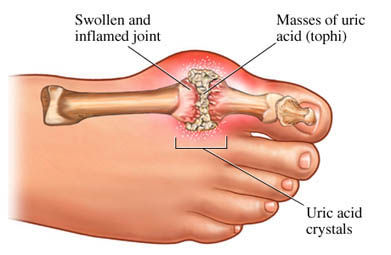 Gout is one of the oldest diseases in the medical literature; and since ancient times, many
authors have written about it as the result of personal excess. It is associated with a diet rich in meat and alcohol that
gained it the predicate, "The king of diseases" and "the disease of kings".
Gout is one of the oldest diseases in the medical literature; and since ancient times, many
authors have written about it as the result of personal excess. It is associated with a diet rich in meat and alcohol that
gained it the predicate, "The king of diseases" and "the disease of kings".
It's a medical condition characterized by recurrent attacks of acute inflammatory arthritis.
This is the onset of (a) red, tender, hot and swollen joint(s).
Gout (or gouty arthritis) is also known as metabolic arthritis; a very painful disease caused by the accumulation of
sodium uric acid crystals in the fluid around joints, tendons, and other tissues. The body attacks these crystals,
causing the tissues to become inflamed.
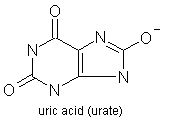 These uric acid crystals, form because of a metabolic disorder called hyperuricemia, which causes elevated
levels of uric acid in the blood.
These uric acid crystals, form because of a metabolic disorder called hyperuricemia, which causes elevated
levels of uric acid in the blood.
Excess uric acid can be caused by either an over-production of uric acid; either by the body or by the under-elimination of
uric acid by the kidneys.
Crystals are deposited in joints, tendons, and surrounding tissues.
The joint at the base of the big toe is the most commonly affected part.
If attacks of gout occur over years, uric acid deposits (tophi) are accumulated in cartilage tissue, tendons,
and soft tissues. This is a risk of serious infection.
Elevated levels of uric acid may also lead to crystals precipitating in the kidneys. The result is stone formation
and subsequent urate nephropathy.
The uric acid comes from breakdown of purines (part of human tissue and also found in food); uric acid is a precursor
for gout.
The first aim of treatment is to settle the symptoms of an acute attack.
Repeated attacks can be prevented by reducing serum uric acid levels.
If left untreated, gout can cause permanent joint- and kidney damage.
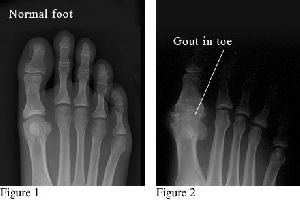 Gout is very painful; often gout first attacks the big toe; also ankles, heels, knees, wrists, fingers and elbows.
Gout is very painful; often gout first attacks the big toe; also ankles, heels, knees, wrists, fingers and elbows.
Lowering uric acid levels in the body may cure the disease.
Gout is associated with the consumption of alcohol, fructose-sweetened drinks, meat, and seafood. Physical trauma
and surgery may also play a role.
Some medicines are also associated with gout such as niacin, aspirin, loop- and thiazide diuretics and cyclosporine.
Urate-lowering drugs (allopurinol and probenecid), can trigger a gout attack due to the sharp decrease in uric acid.
These are not the only triggers though; others are:
obesity, hypertension, hyperlipidemia (high blood fats) and diabetes. Also: fasting, dehydration and body temperature.
Although gout is associated with hyperuricemia, the level of uric acid does not itself cause gout; rather,
acute changes in the level of uric acid do this.
Most individuals with hyperuricemia do not have gout.
However, if high uric acid levels go untreated, 90% of patients will develop gout ultimately.
What are the symptoms of gout?
Limited mobility in the joints that are affected.
The appearance of nodules around the affected area(s).
Warm, burning pain and swelling around the joint; it usually starts in the big toe.
Sudden increase in pain and/or discomfort that may last for the night
and
subsides over the next few days.
Is accompanied by flu-like symptoms with fever and chills.
Gout should be taken seriously and treated effectively!
It gets more serious in the long run and permanent damage to the joints
will happen.
It can lead to kidney disease (kidney stones) and surgery.
Traditional allopathic (mainstream medical) drugs against gout
Treatment with nonsteroidal anti-inflammatory drugs (NSAID's), steroids, or colchicine.
However, NSAID's (such as Ibuprofen) may cause gastrointestinal bleeding and ulcers while colchicine can leech
bone marrow.
Allopurinol (Zyloprim®), side-effects are significant when they occur.
Febuxostat (ULORIC®), side effects may be significant when they occur.
Colchicine (Colcrys®), used in suppressing inflammation caused by gout (acute flares).
Using natural treatments against gout
To prevent future gout attacks, diet (vegetarian), lifestyle changes; drink lots of water,
add raw garlic or onion to your diet. Also use more leafy greens and avoid refined carbohydrates, yeast, gravies, red
meat and alcohol.
Combining effective herbal dietary supplements from the Amazon rainforest can be very helpful.
Many customers combine these tinctures and/or teas:
Acai fruit, antioxidant, contains anthocyanins (flavonoids) are very
effective; inhibit the Cox-2 prostaglandins which carry pain messages,
and reduce inflammation.
Banaba, lowers uric acid; reduces the activity of xanthine oxidase,
the enzyme involved in the production of uric acid.
The ingredient VAD seems to be more effective at managing uric acid levels
than prescription drugs such as allopurinol (Zyloprim).
Cat's claw, against inflammation
Chanca piedra, flushes the kidneys, urinary tract and liver.
Breaks and flush out (crystallized uric acid) kidney stones.
Curcumin (Turmeric), powerful against inflammation and pain.
It is also a strong antioxidant and reduces the activity of xanthine
oxidase [XO], the enzyme responsible for the production of uric acid.
Garlic diallydisulphide a sulfur containing compound, has anti-inflammatory action
on joint inflammation.
Pine bark, against pain; the constituent pycnogenol, may also help to
reduce
inflammation.
A very effective combination of tropical herbs is Banaba, Curcumin, Acai and Pine bark.
However since the majority (over 90%) of people with gout, don't excrete enough uric acid in the urine, it makes
sense to also use Chanca piedra to help getting rid of this from the kidneys and liver.
Other useful tinctures and botanicals are: Bromelain, Acerola, Portulaca.
Remarks
Note that there are other arthritis types that mimic gout symptoms, (pseudo gout).
Diagnosis is through the identification of the crystals.
Pseudo gout is inflammation caused by calcium pyrophosphate (CPP) crystals; in contrast Gout is inflammation
caused by Monosodium Urate Monohydrate (MSU) crystals. Sometimes, both occur together though.
|
|
|
|


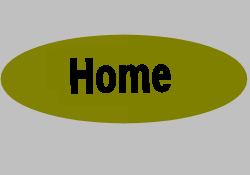
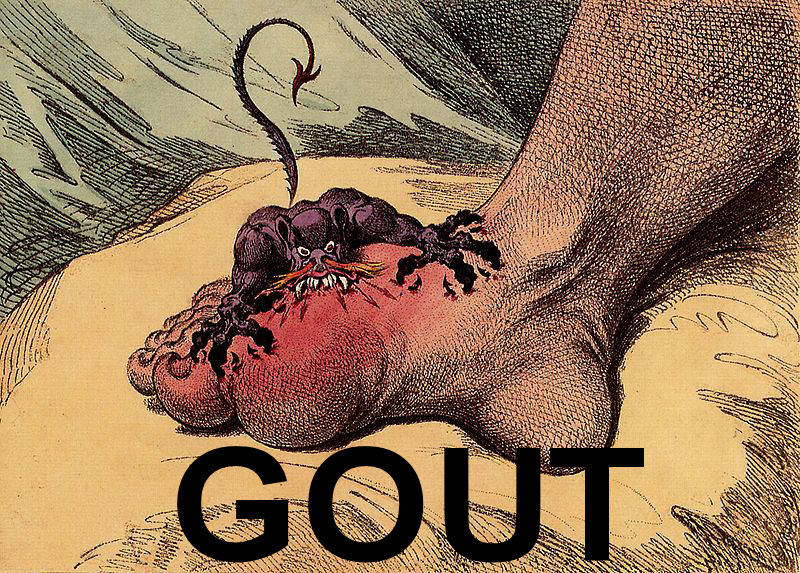
 Gout is one of the oldest diseases in the medical literature; and since ancient times, many
authors have written about it as the result of personal excess. It is associated with a diet rich in meat and alcohol that
gained it the predicate, "The king of diseases" and "the disease of kings".
Gout is one of the oldest diseases in the medical literature; and since ancient times, many
authors have written about it as the result of personal excess. It is associated with a diet rich in meat and alcohol that
gained it the predicate, "The king of diseases" and "the disease of kings". These uric acid crystals, form because of a metabolic disorder called hyperuricemia, which causes elevated
levels of uric acid in the blood.
These uric acid crystals, form because of a metabolic disorder called hyperuricemia, which causes elevated
levels of uric acid in the blood. Gout is very painful; often gout first attacks the big toe; also ankles, heels, knees, wrists, fingers and elbows.
Gout is very painful; often gout first attacks the big toe; also ankles, heels, knees, wrists, fingers and elbows.